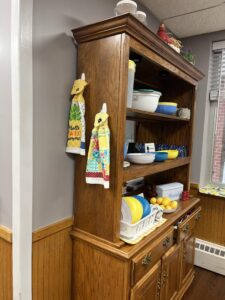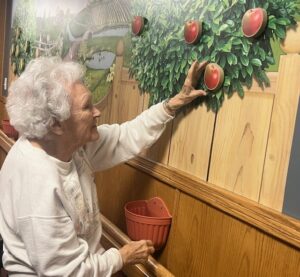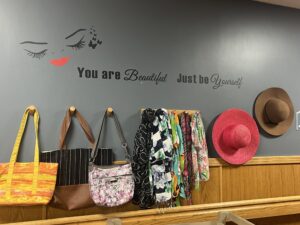How Heritage Pointe of Warren Uses Memory Stations to Support Memory Care Residents
At Heritage Pointe of Warren, a senior living community in Warren, Indiana, strategically placed displays work to trigger residents’ memories and provide meaningful activities for them to engage in. The displays, called memory stations, are the result of volunteer-driven efforts from several independent living residents. Now, the displays are a fixture of the community with more based on the project’s success.
Planning the Memory Stations

Diane Johnson, activities supervisor for Memory Care at Heritage Pointe of Warren
The idea to create memory stations developed over several years, says Diane Johnson, activities supervisor for Memory Care at Heritage Pointe of Warren. As Johnson researched and learned about dementia and programs in other countries, her interest in the project grew. Terrence Jent, the executive director and administrator, believed in and shared Johnson’s vision, and the project began to evolve.
Johnson investigated memory station pictures from other projects. “I looked at our space and considered how we could best use what we had available, especially hallways and shared areas,” she explains. Johnson also considered the backgrounds and interests of the community’s residents and the types of stations that would resonate with them. “For instance, many of our female residents were homemakers and teachers,” she explains. “I thought about what, related to their backgrounds, might best trigger the memories.”
Johnson also considered how residents could interact with the space. From there, she sketched out her ideas and identified supplies needed. She looked specifically for vintage items that residents would have used, such as rotary phones. Johnson sought out donations from family members and the greater community.

Image copyright Heritage Pointe of Warren. Used with permission.
Help from the community’s independent living residents also proved essential to the project. One of the community’s social workers knows many residents who participate in woodworking and reached out to them with Johnson’s ideas. Johnson met with the residents and showed them the ideas. “Some of them visited the memory care unit, and when they understood our vision, they were all in to help,” she says.
The residents volunteered their carpentry skills and helped create the memory stations. “All of us know it could be any of us to have memory challenges, so we were glad to contribute and help,” says resident Mike Reynolds. Reynolds and other residents helped to replace glass shelves in a kitchen hutch with wooden shelves, making the memory station safer for residents to use.
The Value of Memory Stations
Johnson explains that memory stations are displays of familiar items. They can help spur activity, engagement, and memories, including things that the residents remember how to do. “When the memory takes over, which includes muscle memory, it stimulates [the residents] and keeps them active, engaged, and exploring,” says Johnson. “If it’s something they can explore on their own, that especially has a significant impact.” She notes that as residents become involved with the memory stations, they don’t want to wander or leave. “They don’t even notice the door,” Johnson says. “They’re more at peace in their environment. They feel purposeful.”

Image copyright Heritage Pointe of Warren. Used with permission.
Memory stations also stimulate socialization and facilitate interaction with loved ones. When family members visit, the resident may not remember who the visitor is. “But if they’re in a memory station, the visitor can start interacting with the station and the resident is likely to do so alongside them,” says Johnson. “For instance, a nephew comes to visit and goes to the fishing station with the resident. They can look at the equipment and pictures and talk about fishing stories together.” They can participate in the activity alongside each other without having to have a back-and-forth conversation.
Examples of Heritage Pointe’s Memory Stations
The memory stations created so far feature varied settings and activities designed to connect with many different residents. They include:
- A birdwatching station adjacent to a big window in the dining room features bird feeders, bird books and pictures, binoculars, and cages with fake birds that are stimulated to chirp by sound.
- A kitchen station with a hutch holding plates and bowls. The station features a table that residents can set, as well as towels, utensils, potholders, and a drying rack.
- A laundry station with a clothesline, clothes pins, an apron, towels, and washcloths.
- A farming station with items that would be used on a farm, pictures, and equipment.
- A fishing station with fishing poles, lures, a scale, and wooden fish.
- A painted mural of trees overlooking farmland features magnetic wooden apples and pears that residents can pick.
- A “Be Beautiful” station features pegs holding scarves, hats, purses, and fun signs.
- A baby station features baby dolls, a crib, a diaper bag, bottles, and baby clothes.
- A flower station includes hydro gardens.

Image copyright Heritage Pointe of Warren. Used with permission.
Johnson explains that the memory stations are always a work in progress, but that residents’ response to the stations has been positive. “It’s a joy to watch the residents’ reactions as their memories are stimulated,” she says.
Johnson advises other communities that might want to create memory stations to carefully consider their residents’ backgrounds. “It’s important to know your residents, what they desire, what they enjoy, and what their pasts have included,” she says. She recommends communities reach out to residents’ families. “The project is worth all of the effort,” Johnson notes. “And the sky’s the limit. It brings [residents] back to what they’ve enjoyed and gives a sense of joy and purpose. It’s so important.”

Paige Cerulli is a contributing writer to i Advance Senior Care.
Related Articles
Topics: Activities , Alzheimer's/Dementia , Facility management , Featured Articles , Housing , Operations , Rehabilitation











